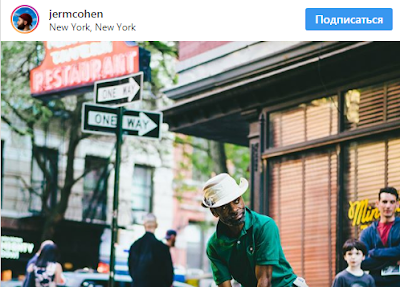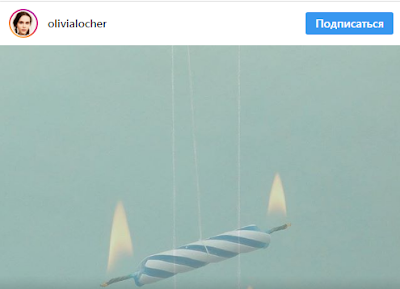
It's Instagram's world, and we're all just living in it. The Facebook-owned, image-based
social media platform reached 700 million monthly active users last year, which means 700 million monthly opportunities to scroll through filtered photos of sunsets, brunches and the Brooklyn Bridge. Fortunately, nestled among those millions of users is a community of artists using the platform to create and share discourse-worthy work.
We caught up with four SVA graduates with sizeable Instagram followings to find out how they have integrated the platform into their careers. Jeremy Cohen (BFA 2014 Photography) has over 140,000 followers across his two Instagram accounts, @jermcohen and @todayiphotographed, and specializes in portraiture. He has worked with everyone from major brands like Dunkin Donuts and Mercedes Benz to stars like Miley Cyrus. Lauren Hom (BFA 2013 Advertising), @homsweethom, is a hand-letterer and illustrator with over 145,000 followers. Her clients include Google and Starbucks and in 2014 she published Daily Dishonesty (Abrams), a collection of work posted to her account on another social media platform, Tumblr. Olivia Locher (BFA 2013 Photography) has 78,000 followers for her account, @olivialocher. She has photographed for The New York Times Magazine and Vanity Fair; last year she published her first book, I Fought the Law (Chronicle). Painter Jenny Morgan (MFA 2008 Fine Arts)—@jenny_morgan_jm; 32,000 followers—focuses on nude portraiture. Her work has been shown in galleries from New York to Colorado to London, and has been featured in such magazines as New York and Juxtapoz.
When did you join Instagram? Was it originally something you intended to use as a platform for your work or just as personal social media?
Olivia Locher: I joined sometime in 2012 after hearing a lot of my friends working in creative fields boasting about how great it was. I was initially pretty clueless to how it all works. I was posting ugly, low-quality phone images. As time progressed, people started using it in a much smarter way, and my posts also matured.
Lauren Hom: I joined in 2013, but I stumbled across Instagram [as a career tool] almost by accident. I was waiting for the train one night and I snapped a photo of my sketchbook in my hands on the subway platform. Before that moment I had never really thought to share my process on Instagram. I just happened to one night and I realized that the photo I posted of just my crappy sketchbook got almost triple the number of likes my photos usually got. I was like, "Hmmm, maybe people would like to see more of that."
Jeremy Cohen: I was a freshman at SVA when Instagram launched. I downloaded it, posted a photo of a dog I saw through a car window and then didn’t really use it too much for a few years. It wasn't until 2013 that I saw the potential of the platform and started to take it more seriously.
Jenny Morgan: I joined in 2011, soon after the app was started and before it had such a large community. At that time, I used it as a way to connect with close friends and occasionally post images of my work in process. Over the past six years, I've witnessed the magnitude of Instagram's development and the impact it's had on the way art is shared and viewed.
Was there a specific moment or piece or post that seemed to be the tipping point for your developing a following on the platform?
JC: I went to an Instagram/bicycle meet-up in fall 2013, which in retrospect turned out to be one of the best decisions I've ever made. It was there that I got connected with the Instagram community of New York City. After that, I was motivated to start posting more. I started making projects through Instagram hashtags, like #pizzaportraitz and #emojiportraits. At the time, Instagram had this feature where it would suggest users [for people to follow] in a two-week rotation. Sometime later that year, I was picked as a suggested user and was flooded with new followers.
OL: At first I started using Instagram as another way to see what my friends were up to. Instagram was—and still is—a great way to get recommendations for things like art shows, albums and coffee shops. After I started working with commercial clients in 2013, I saw the strong emphasis on sharing your work and tagging your team. It’s basically a requirement these days to get as many eyes on something as possible. Instagram also made me a suggested user.
LH: It never really occurred to me before that you could use Instagram to post images you had designed. I just thought, like everybody else, that Instagram was for photos taken from your phone in real time. Once I realized I could upload a JPEG, and it didn’t matter if I had designed it two years ago or yesterday—it just snowballed from there.
Do you have a strategy when it comes to what you choose to post on Instagram? How, if at all, do you curate your feed?
JC: I treat my feed as a portfolio. When someone views my profile, I want it to look good at first glance. I set up posts strategically so they'll look cohesive and clean as a whole. I do this by varying colors, compositions and subject matter. I use an app called UNUM, which allows me to drag and drop photos easily to see what they'll look like in my feed before I post.
JM: I try to maintain an intuitive relationship with the platform. I don't operate in terms of strategy; instead, I focus on what feels positive and relevant for me to share with a viewing audience. Instagram is an intensely complex matrix—the confluence of imagery and opinion. I think of my feed as a reflecting pool. I understand that what I post will shape the way the world views my work and me as an individual. When my following started to really grow, I chose to be less open with my personal life in order to protect myself a bit.
OL: I don't have a strategy, per se. Sharing my work is obviously my favorite part of the app and the most rewarding. Sometimes it feels like a huge pressure to be prolific, so I end up sharing a lot of lifestyle stuff and self-portraits. Instagram has made the demand on visual artists very tough. The reality is we don't always have new pieces to share. My Instagram is a true extension and balance of my life and work. I share things that I'm experiencing: books, films, concerts—and most importantly, my studio practice.
LH: I try to do everything organically. There's this sense of urgency and anxiety that people tend to get about social media. I understand the strategy [of posting on a regular schedule], but now that I'm a little bit more established I tend to post when I feel like it and worry less about Instagram's algorithm. I also write pretty hefty captions to go with my posts. They're almost like miniature blog posts.
Instagram has faced a lot of flak for how it handles "graphic" or so-called NSFW imagery. Has this been something that has affected you?
JM: I work with the nude and most often female [nudes], so I'm usually crossing a boundary with my work in general. There are many complex social boundaries around the female nude. I'm never surprised or angered when an image I post is flagged because it crossed a viewer's personal comfort zone with exposure or vulnerability. I'm hyper-aware that my content is of a sensitive nature. Artists challenge social norms through their imagery, and I think the platform is still learning how best to monitor and police artistic expression.
Do you find your followers respond more strongly—either in positive or negative ways—to certain types of posts?
OL: I try not to pay attention. I've found the things that are the most personal always get the lowest amount of likes. Unfortunately, I've also found self-portraits always generate the most likes.
JM: I find that followers are more attracted to images of artwork as opposed to personal posts, and when it comes to the work itself, strong bright colors are most "liked." This observation feels extremely simplistic in terms of art making, which is why I try to not focus on the popularity of any given post.
JC: Absolutely, but that's part of the whole game of anything being online. What's the other option—not posting? That's not a good idea if you want your work to be seen. Another option is watermarking, but the only watermarked images are usually ones that people don't want to steal anyway. Similar to how parents can be overprotective, I think it's important as a photographer to not live in fear of your images being stolen.
LH: I have always been of the mentality that the pros outweigh the cons when it comes to sharing your work on social. The reason I have my entire lettering career is because I started a Tumblr with my work. I think CEOs, people who run brands, art directors and creative directors at companies, they use Instagram the same way we all do—randomly scrolling through their "explore" feed. You never know who is going to see things.
http://www.sva.edu/features/talking-instagram-with-some-of-svas-most-followed-alumni




Комментариев нет:
Отправить комментарий